The Amazing Brazilian Eagles
It is difficult for most people to tell the difference between an eagle and a hawk, and in fact both birds are very similar, after all they are part of the same family. Simply put, we call large, strong, and imposing birds “eagles” and smaller ones “hawks. Eagles typically hunt and kill vertebrates (usually mammals) with their powerful talons, build large nests high in the trees or on cliffs, and have only one chick per season.
Different lifestyles have resulted in different adaptations for certain species. For example, forest-dwelling eagles tend to have relatively small wingspans, a trait necessary to maneuver quickly in a forest environment. Open-field eagles, on the other hand, are known for their ability to fly high and for having relatively long wings for their size.
There are more than 70 species of eagles in the world - in Brazil there are 9, or about 12% of the world’s eagles. See them below.
1 - Solitary eagle (Urubitinga solitaria or Buteogallus solitarius)
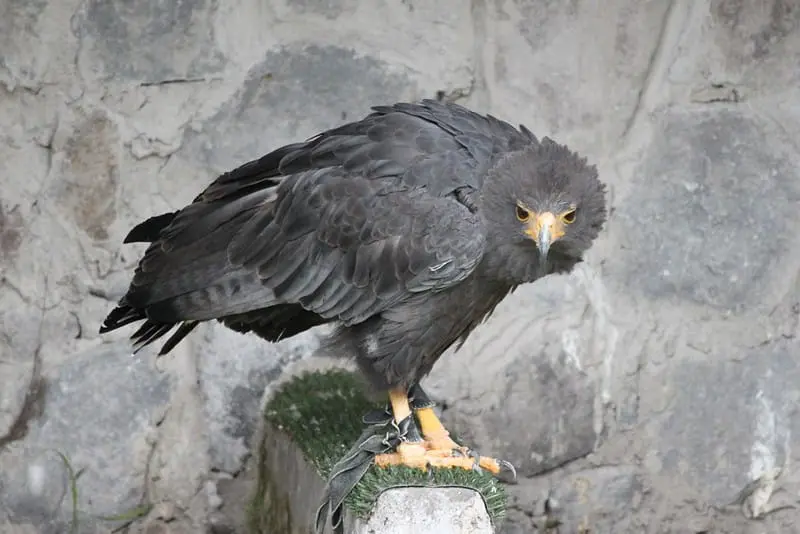
Its first record on national territory was made only in 2019 by ornithologists Tony Bichinski and Willian Menq. It is a species that is still little studied, especially in Brazil. Until now, it has only been found in the high forests of Roraima, where it flies from 600 to over 2,000 meters above sea level.
It weighs about 3 kg (6.6 lb), and the largest individual recorded has a wingspan of 1.88 cm (6 ft). Its plumage is gray with a white stripe on the tail. It is easily confused with the Black Hawk and the Black-crested Hawk, but the Solitary Eagle is larger and its wings are wider.
The Solitary Eagle is rare throughout its range, which stretches from Mexico to northern Argentina. There are an estimated 1,000 to 2,500 adult animals - which classifies it as Near Threatened; but in some countries such as Venezuela and Colombia, it is Critically Endangered.
2 - Black-chested buzzard-eagle (Geranoaetus melanoleucus)
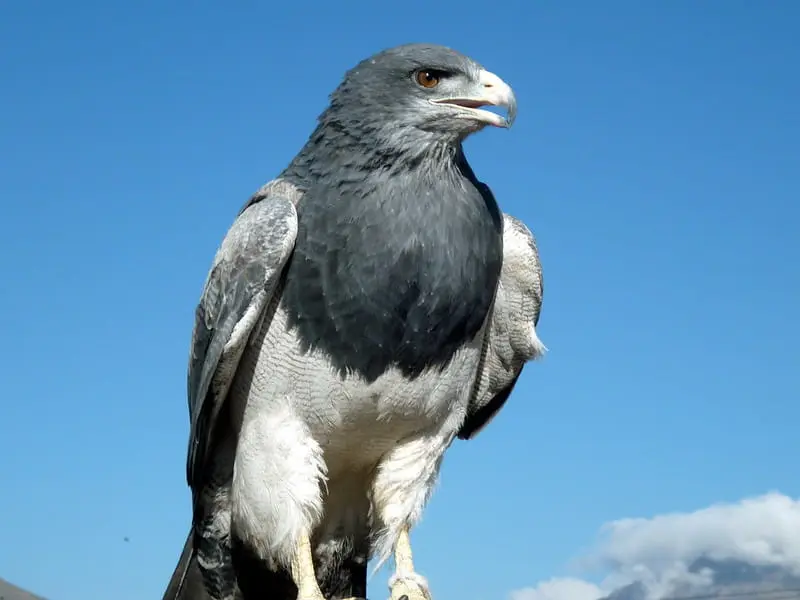
It is also known as black buzzard-eagle, and gray buzzard-eagle. Its neck and head are dark gray, its wings have various shades of gray, and its chest and belly are white. It has a wingspan of up to 2 m (6,5) and weighs between 1.5 kg and 3 kg (3 to 6 lb).
It is one of the few Brazilian eagles with subspecies, and among the two existing ones, only one - the G. m. melanoleucus - inhabits southeastern Brazil, as well as Paraguay, Uruguay and northeastern Argentina.
It is one of the most common and adaptable eagles in the country, sometimes seen in urban areas. However, in some regions, such as the south, its sightings have become increasingly rare. It inhabits mountainous and rural regions all over Brazil and is not only found in the Amazon rainforest.
3 - Harpy eagle (Harpia harpyja)
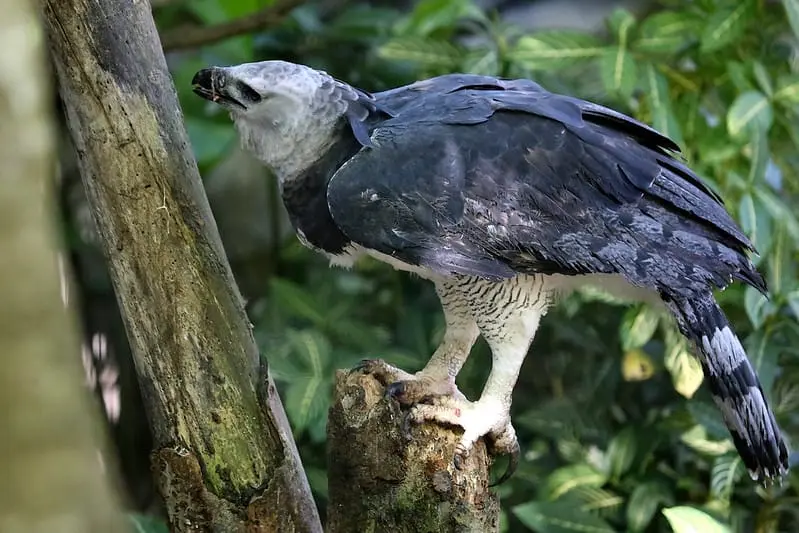
It is one of the most famous eagles in Brazil, mainly because of its size and splendor. It is the second largest eagle in the world, with females reaching 9 kg (19.8 lb) and a wingspan of 2 m (6.5 ft). Its claws, however, are the largest of any eagle, at more than 9 cm (3.5 inches), larger than those of a brown bear. With such powerful claws, the harpy eagle is also the strongest eagle in the world, capable of capturing prey as heavy as itself.
Some birds, such as the harpy eagle and the gray eagle, can be confused with the harpy eagle, but the harpy eagle is much larger. It has a dark back, a gray head, a black collar around its neck, a white belly, white legs with black stripes, and several feathers in its plume. Like owls, harpies have a disk of smaller feathers around the face that help direct sounds by improving hearing.
It is a key species that indicates the health of an environment. Because it is at the top of the food chain, its presence indicates that all other species in the ecosystem are in balance. Originally, the harpy eagle was present throughout Brazil, except in some regions of the Northeast. Today, however, it is endangered and can only be found in the Amazon Rainforest and in some regions of the Atlantic Forest, where there are still forests suitable for its survival.
4 - Crested eagle (Morphnus guianensis)
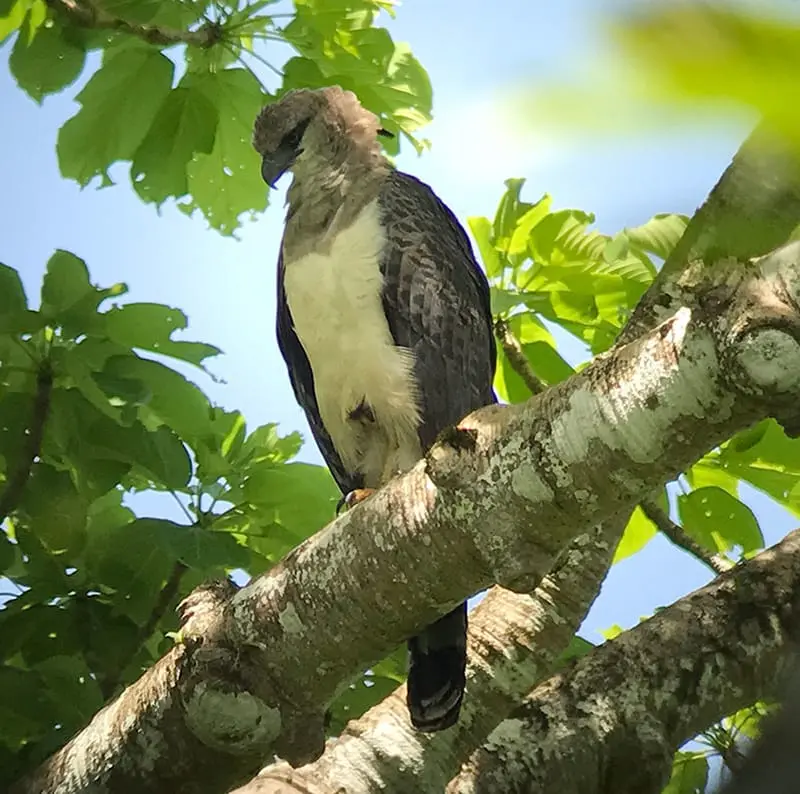
The feathering and head make it relatively similar to the Harpy Eagle. However, Crested Eagles are much smaller, weighing just over 1 kg (2 lb), with a wingspan of up to 1.60 m (5 ft). They have only one large feather on their head, a black mask around their eyes, and a chest that is usually white with beige stripes, but in melanistic individuals is black with white stripes. Studies indicate that the Crested Eagle and the Harpy Eagle are genetically similar and that there is no justification for keeping them as separate genera.
The Crested Eagle used to live in most parts of Brazil, but with the decline of forests (especially in eastern Brazil), its numbers have been severely reduced. It is now found mainly in the Amazon rainforest, with only a few individuals in the Atlantic rainforest. It was rediscovered in southern Bahia in 2015 - the only previous record of the animal there was in 1817.
According to the IUCN Red List of Threatened Species, it is classified as “Near Threatened”, but this classification can vary from state to state. In Rio de Janeiro, for example, the species is considered regionally extinct.
5 - Chaco eagle (Buteogallus coronatus or Urubitinga coronata)
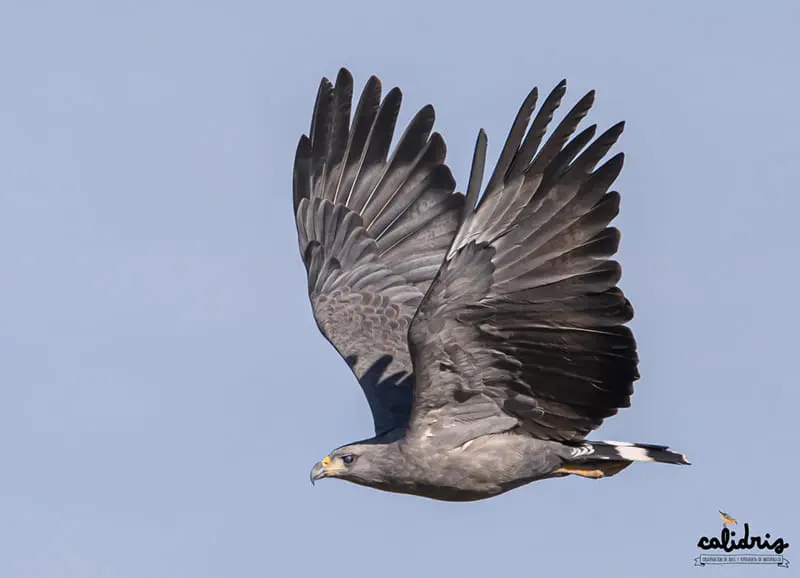
It is also known as the crowned solitary eagle. Although at first glance it looks like a harpy eagle, mainly because of its color and feathers, it is not part of this group. In the last 10 years, it was classified as Harpyhaliaetus (the same group as the harpies), then as Urubitinga (genus accepted in Brazil) and as Buteogallus (used abroad).
They usually weigh a maximum of 3.5 kg (7.7 lb) and have a wingspan of 1.8 m (6 ft).
The Chaco Eagle usually inhabits the Cerrado and the Atlantic Forest, mainly in the South, Southeast and Midwest, always near fields and savannas. It is estimated that there are less than 1000 individuals in all of South America, making it one of the rarest birds of prey in Central and South America.
6 - Osprey (Pandion haliaetus)
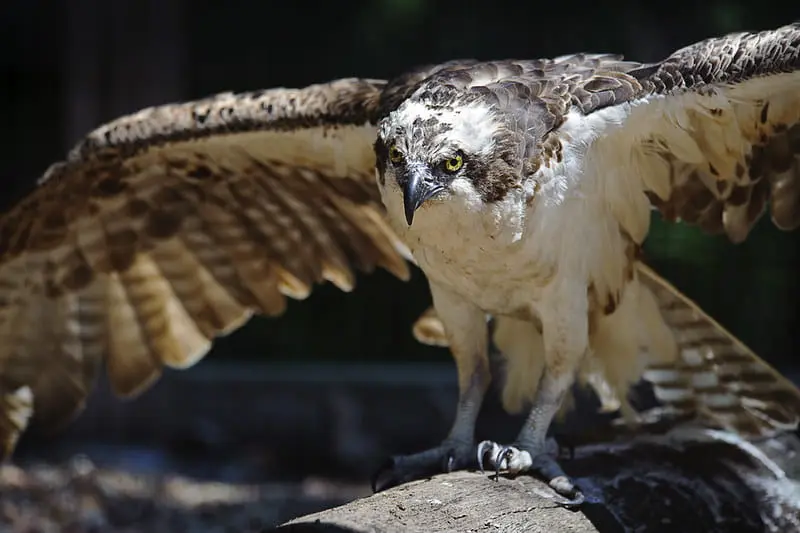
The osprey feeds mainly on fish, and just before catching them, it dives like a spear with its wings back and talons forward.
Its physique distinguishes it from any other Brazilian eagle. It has a small head and its wings are thinner and usually folded slightly during flight, forming a “V”. One of the most peculiar characteristics of this eagle are the small spikes on its feet, which prevent the prey from escaping. Its back and wings are dark brown, and its head, chest, and neck are white, with a few brown spots on the young. Its tail is striped and it has a noticeable brown stripe from the back of the eyes to the nape of the neck. Females can weigh up to 2 kg (4.4 lb) and have a wingspan of 1.75 m (5.7 ft).
Native to the Northern Hemisphere, the Osprey is the only eagle in the country that has migratory habits. There are about three subspecies, but only the P. h. carolinensis is found in Brazil. They can be seen throughout the year in South America, but are more common during the months of October to April (when they migrate in search of warmer temperatures), flying along the banks of rivers, lakes and coastlines.
These eagles fly for about 25 days, covering about 200 km per day in 8 hours of flight, stopping only to feed and rest. Eagles migrating from the Americas, on the other hand, can fly for up to 40 hours at a time.
7 - Ornate hawk-eagle (Spizaetus ornatus)
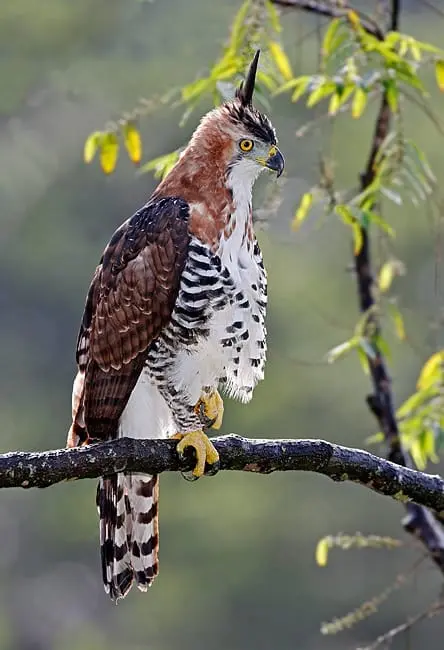
Despite its name, the Ornate hawk-eagle is simply an eagle. Its wings and back range in color from dark brown to black, its belly and legs are white with black stripes, as are its tail and the undersides of its wings. The throat is white, bordered on each side by a black stripe that runs from the sides of the bill to the chest. The sides of the face and neck are brown, and the top of the head, where the crest is, is black.
As with most eagle species, females are larger than males, reaching 1.5 kg (4 lb) and a wingspan of 1.40 m (5 ft).
The Ornate hawk-eagle is a forest eagle found primarily in the Atlantic Forest and Amazon Rainforest, but can also inhabit the Cerrado. Two subspecies are known, but only S. o. ornatus is found in Brazil.
Its conservation status varies from place to place. In the Amazon rainforest, the species is “near threatened”. In the Atlantic Forest and the Cerrado, it is “critically endangered”.
8 - Black hawk-eagle (Spizaetus tyrannus)
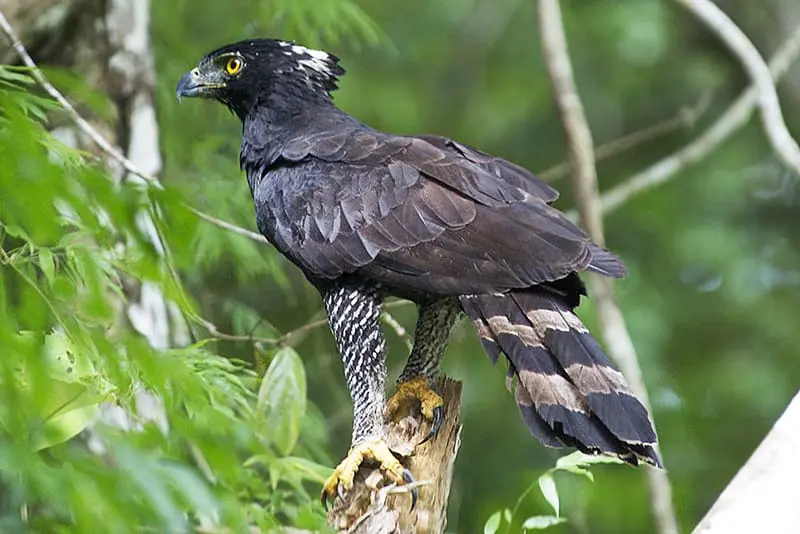
It is an eagle of the same genus as the Ornate hawk-eagle. Its name comes from its habit of hunting monkeys, especially marmosets. It weighs a little over 1 kg. It has a black-brown plumage, with gray stripes on the tail, legs, and inside of the wings. It has a small black crest with a white feather base, and is smaller and bulkier than other eagles.
There are two subspecies, S. t. tyrannus, found in the south and southeast, and S. t. serus, which is slightly smaller and found only in northern Brazil.
It is a relatively common eagle that tolerates some deforestation. Like the Ornate hawk-eagle, it is a forest eagle and inhabits the Amazon Rainforest, the Cerrado and the Atlantic Forest - it is more common in the latter biome.
9 - Black-and-white hawk-eagle (Spizaetus melanoleucus)
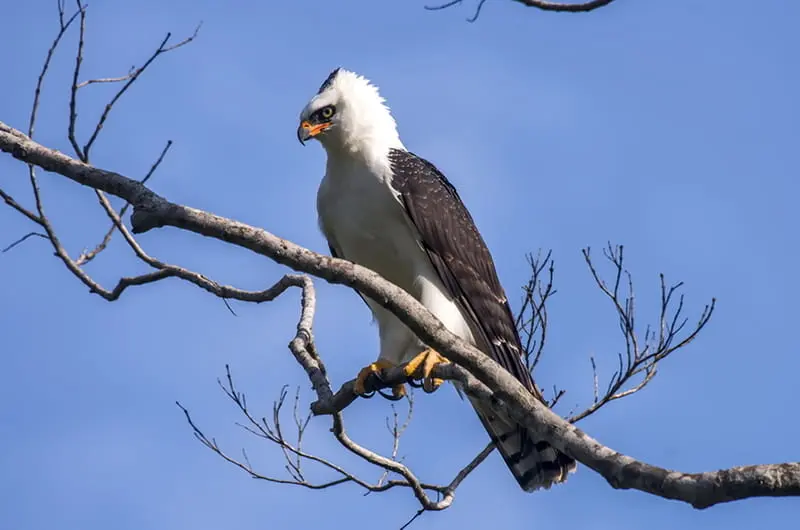
Like the Ornate hawk-eagle and the Black hawk-eagle, it is an eagle belonging to the genus Spizaetus. it is an eagle of the genus Spizaetus. It inhabits the edges of forests, scrubland or the Cerrado. It is the smallest eagle in Brazil, weighing about 850 g (2 lb) and with a wingspan of about 1.15 (5 ft). It has a black back and wings and a black topknot. It has a small black mask around its eyes and the tip of its bill. Its head, chest, belly, and legs are white. Only the inner part of its flight feathers and its tail are striped.
Of the three eagles of the genus Spizaetus, the Black-and-white hawk-eagle is considered the most difficult to sight. It is found throughout Brazil, with the exception of the Caatinga and the Pampas. In the Atlantic Forest, however, it is threatened with extinction.
Most eagles in Brazil are threatened in some way, mainly by deforestation. These birds need large, undisturbed territories to fly over and hunt their prey. But with the degradation of the environment for mining, hydroelectric dams or logging, their territory is becoming smaller and smaller.
Moreover, illegal hunting is also an aggravating factor. Many eagles are killed by farmers out of curiosity or fear that their animals will be captured. Some people even believe that large eagles like the harpy eagle can even take children — which is not true.
Over the years, several projects have been created throughout South America - such as environmental awareness, conservation and monitoring programs for various species - to help them thrive. We hope that in a few years these efforts will bear fruit and provide these amazing animals with a suitable environment for their survival.
Leia mais em:
Primeiro registro de águia-solitária, Urubitinga solitaria (Accipitriformes: Accipitridae) no Brasil
